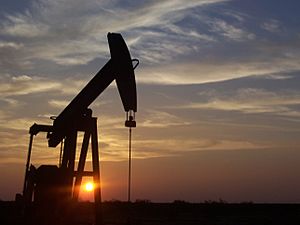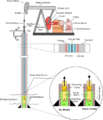Oil well facts for kids
An oil well is a special hole drilled into the ground to find and bring up petroleum, also known as crude oil, or natural gas. Petroleum is a very important natural resource that we use to make gasoline for cars, plastics, and many other products.
People who work in the petroleum industry search for places deep underground where oil or gas might be trapped. Once they find a promising spot, they drill a very deep hole. If oil or gas is there, they use special equipment to pump it up to the surface. Most of the oil we use is found far below the ground.
Contents
Different Kinds of Oil Wells
Not all oil wells are the same! They can be used for different purposes, like finding new oil or bringing up oil that's already been discovered.
Wells for Finding Oil
- Exploration wells are drilled to look for new places where oil and gas might be. Think of them as scout wells, trying to discover new hidden treasures.
- Wildcat wells are a special type of exploration well. They are drilled in areas where no oil or gas has ever been found before. It's a bit like exploring a completely new, unknown territory!
Wells for Getting Oil and Gas
- Production wells are the wells that actually bring oil or natural gas out of the ground. These are the wells that produce the energy we use every day.
- Oil producers mainly bring up liquid oil, though they might also produce some natural gas.
- Gas producers mainly bring up natural gas.
- Injection wells are used to put things back into the ground. This helps keep the pressure right in the oil and gas reservoirs, making it easier to get more oil out.
- Water injectors put water back into the ground. This water might be from underground water sources or water that came up with the oil.
- Gas injectors put natural gas back into the ground. This helps keep the pressure up in the oil and gas layers, or it can be used to store gas that isn't needed right away.
How Wells Are Drilled
Wells can be drilled in different ways, depending on where the oil or gas is located underground.
Straight (Vertical) Wells
Straight wells are drilled mostly straight down into the ground. Even though they aim to go perfectly straight, the hole might curve a little bit as it goes deeper. These wells are used when the oil or gas is directly below where the drilling rig is set up on the surface.
Directional Wells
Directional wells are drilled at an angle. This means the bottom of the well is not directly under the drilling rig on the surface. These wells are very useful when:
- The oil or gas is under a place where you can't put a drilling rig, like under a lake, a city, or a mountain.
- You want to reach several different oil pockets from one drilling spot on the surface.
Horizontal Wells
A special type of directional well is a horizontal well. After drilling down for a while, the wellbore (the hole) turns sideways and goes horizontally (flat) through the rock layer that holds the oil or gas. This horizontal part can stretch for hundreds or even thousands of feet! Horizontal wells are great because they can touch a much larger area of the oil-rich rock, which helps to get more oil or gas out of the ground.
Images for kids
See also
 In Spanish: Pozo petrolífero para niños
In Spanish: Pozo petrolífero para niños













